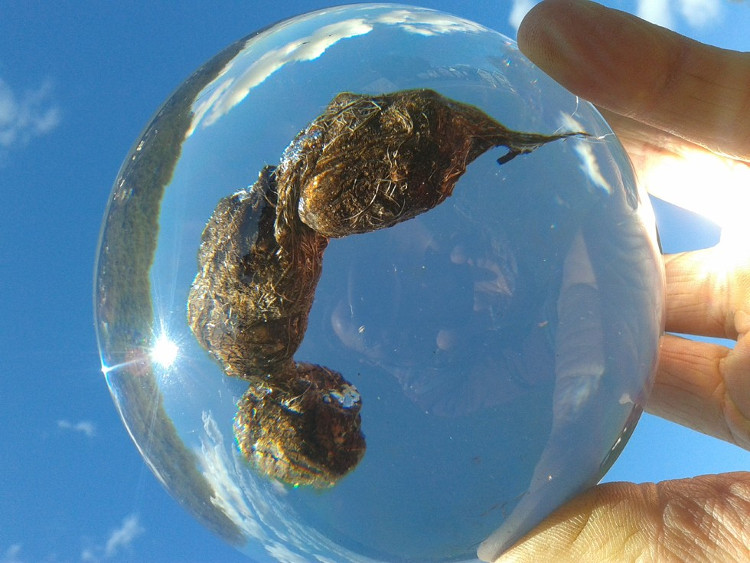Unexpected applications from animal waste
The medium is in the food chain of many insects, helping scientists discover history and preserve rare animals.
People often avoid talking about faeces because they think they are dirty and scum. However, with science and many animals, this waste brings valuable information.
Museum stool
Scientists at the Isle of Wight Zoo in England open a museum displaying 20 samples of dried feces in glass spheres. Fecal samples are collected from many species such as lions, African weasels, skunks, and even babies.
"Samples vary in size, shape, texture, detail and reveal special information , " said Nigel George, museum manager.
According to him, even a normal person can learn more about animals as their diet after analyzing stool samples. For example, cow dung usually contains a lot of bones and hard beetles.
"Waste-eating predators smell better than herbivores," George added.
In addition, traces of plastic waste in seagull also indicate negative impacts of humans on nature.
The team took a lot of effort to create "less stinking and safe for the public" specimen . Since the amount of fecal water accounts for 75%, the group devoted a year to a special manure dryer.

The unique stool museum in England showcases 20 manure samples in glass balls.(Photo: Isle of Wight Zoo Stool Museum).
Depending on the size, stool samples can take from one day to two weeks to complete the drying process. Then, the feces are put inside the glass globe that has been removed from the air.
Opened in March this year, the museum helps change the perception of many people about the type of waste that is subject to many stigma.
"Everyone's reaction was not as we thought it. The disgusting feeling was quickly wiped out. Everyone began to head into each sphere to observe carefully , " he said.
Whale feces help the nutrition chain on Earth circulate
While most marine animals feed near the water surface and discharge feces in deeper waters, whales have opposite behavior. This makes the difference, according to Joe Roman, a biologist at the University of Vermont, USA.
"When the whale rises to the surface, right after the last dive, it is time for them to release large amounts of manure , " Roman explained.
Whale feces are known for their high nutrient levels, supplementing large amounts of nitrogen, iron and phosphorus for surface water.
"So they help the ocean more" fertile. "The whale carries nutrients from the seabed to the surface water," Roman said.
This effect is known as the "Whale Pump", which Roman spent 10 years of research.
Nutrition on the surface layer can be fish such as consumption salmon. In turn, salmon become food for seabirds and their offspring on land. Seabirds are then eaten by other species on land. Therefore, Roman insists "whales contribute to bringing nutrition from the sea floor to the terrestrial ecosystem".
The composition of whale feces depends on each individual and diet. Mollusc whales usually have red or pink feces, ingots, and diameter with fists. If they eat fish, they decompose into large, dark green, which can be as large as a research vessel.
"This is the instant nutritional supplement for the ocean. Both types have the same effect but in two different ways," Romans said.
Food for beetles
For some animals, feces are a valuable source of food.
"The remaining nutritionally dependent faecal animals remain originally unabsorbed from food," said Marcus Byrne of the University of Witwatersrand Johannesburg, South Africa.
Byrne began to study faecal species such as beetles, flies and even butterflies, in Australia in the 1980s.

The beetle is a fecal species known for its ability to squeeze manure into rounds to move and to orientate by signals in the sky.(Photo: Rolf Nussbaumer Photography).
The beetle is an animal that has the ability to be impressive, although its brain size is only as small as a grain of rice. They are famous for molding into balls and rolling over long distances.
Their fertility and mating partners also developed surprisingly. Males often show off their power with big horns on their heads.
"Even though they are small creatures, their fighting for mating rights is as fierce as antelope, deer or reindeer," Byrne insisted.
Males that lose in appearance often have testes that grow more than big ones to increase their advantage. Besides, beetles also stand out by their direction.
"They look at the sky and use signals to locate," Byrne explained.
If humans depend on maps, beetles are capable of exploiting things we don't see as polarized light. Observations by scientists show that they often stand on a stool ball, observing the Galaxy as a compass in the sky to determine the direction and move at night.
- 8 unbelievable science applications from simple things
- Motorcycles run on animal waste
- Utilizing food waste - a new mission of biotechnology
- Energy-rich foods help reduce animal waste
- America develops technology to separate water from animal waste
- Pig farming ... odorless
- Battery manufacturing works with animal dung
- Waste, animal fat in chewing gum, tattoo ink
- Top best science apps for phones
- Lobster eyes and unexpected applications in X-ray technology
- Where to combat waste in IT applications?
- New product: Brick made from animal blood
 'Fine laughs' - Scary and painful torture in ancient times
'Fine laughs' - Scary and painful torture in ancient times The sequence of numbers 142857 of the Egyptian pyramids is known as the strangest number in the world - Why?
The sequence of numbers 142857 of the Egyptian pyramids is known as the strangest number in the world - Why? History of the iron
History of the iron What is alum?
What is alum?